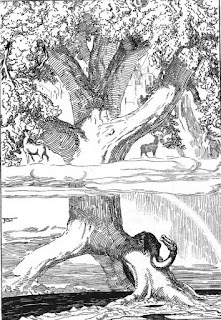 In the fictional high fantasy-world of J. R. R.
In the fictional high fantasy-world of J. R. R.Tolkien, the War of the Ring was fought
between Sauron and the free peoples of Middle-earth for control of the One Ring and dominion
over the continent.
The War of the Ring took place at the end of the
Third Age. Together with the Quest of Mount
Doom, it is one of the overarching events of The
Lord of the Rings. Gandalf and Elessar Telcontar led the free peoples of Middle-earth to victory
over the Dark Lord.
The war was started by Sauron, who had gained strength since the end of the Second Age and sought the One Ring he had forged and into
which he had invested much of his power, and that he had lost in the climactic battle of the prior age.
Battles were fought in Gondor, Rohan, Lothlórien, Mirkwood, at the Lonely Mountain and at Dale.
These were primarily waged against Sauron's forces, but Saruman, an ally of Sauron, also had
armies, who fought battles at the Fords of Isen, Helm's Deep and The Shire.
The war ended after the Battle of Bywater and, shortly afterwards, the deaths of Saruman and
Gríma Wormtongue. Towards the end of the War of the Ring, Elessar was crowned King of Gondor,
and forgave the Men who had fought under Sauron, heralding a great renewal of co-operation and
communication between Men, Elves, and Dwarves.
In the Poetic Edda ( Norse Mythology )
However, no source gives a list of exactly which worlds comprise the nine. Based on the kinds of
beings found in Norse mythology and the reference to their homelands in various literary sources,
however, we can compile the following tentative reconstruction:
Midgard, the world of humanity
Asgard, the world of the Aesir tribe of gods and goddesses
Vanaheim, the world of the Vanir tribe of gods and goddesses
Jotunheim, the world of the giants
Niflheim, the primordial world of ice
Muspelheim, the primordial world of fire
Alfheim, the world of the elves
Nidavellir/Svartalfheim, the world of the dwarves
Hel, the world of the eponymous goddess Hel and the dead
With the exception of Midgard, these are all primarily invisible worlds, although they can at times
become manifested in particular aspects of the visible world. For example, Jotunheim overlaps with
the physical wilderness, Hel with the grave (the literal “underworld” beneath the ground), and Asgard with the sky.Yggdrasil appears in at least one view to
represent the present and the wells from which it draws nourishment the past. together they create a constant birth (Yggdrasil) from previous events
(the wells). Simply, Yggdrasil represents the present, all that is, where as the wells the past, all that has come to pass.
Yggdrasils mighty roots draw up the past and
creates the present. Into the well of Hvergelmir fall dew drops from
the antlers of Eikþyrnir (A stag) as he chews upon the branches of a tree that stands above Valhalla called Læraðr.
There is much debate over whether or not this treeis Yggdrasil, but even if Læraðr is a separate tree
we still have a template we can use. Atop of
Yggdrasil we also find four stags by the names of
Dáinn, Dvalinn, Duneyrr and Duraþrór, which like
Eikþyrnir eat the new shoots.
Although it is not attested that from their antlers
fall dew drops, it is without doubt a possibility.
Especially given as one of them is called Dáinn, which literally means “death” so could be seen to
symbolise the death of the present, thus it becomes the past and falls down below back into the well.
Even without that explanation for how the dew is produced, we know that dew falls from Yggdrasil.
In the Völuspá it mentions that from Yggdrasil falls dew drops making the land below forever
green.
The dew drops falling represent that, that has just come to pass. With the well of Urd said to be
directly under Yggdrasil, this dew would eventually fall back into it, thus eventually being drawn
back up by Yggdrasils roots.
All of this gives a cyclical nature to life, past affects the present and the present adds to the past.
You could also imagine this rather symbolically as a Serpent eating its own tail......
This concept is mirrored in the Germanic languages, whilst we have words for past and present
tense we lack words for future tense. for example, we have phrases like, I’m sleeping or I slept, but
we do not have a word describing us sleeping in the future.
To do this we have to add a verb, so we say “I will sleep”, where as in French they can simply say
je Domerrai.
It is interesting also to note that the verb we use is “will”, by our will, we will it. So even when we
speak of future events we emphasise the need for action, it is not some certain event we have no
control over.
